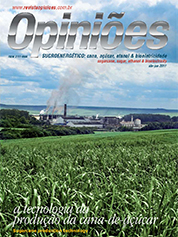João Eduardo Azevedo Ramos da Silva
Professor of Logistics of UFSCar
Op-AA-28
Planning of agricultural operations with discrete event simulation
Processes used in the production of sugarcane, such as soil preparation, planting, cultivation and transportation, are performed using large equipment of high acquisition cost. Planning such processes is a complex task for mill managers, given that apart from the investment, there is the operational risk that production objectives may not be achieved.
In particular, the sugarcane cutting, loading and transportation system – CLT, requires detailed planning, given that the continuous supply of sugarcane during harvesting depends on good management of these operations. In some companies, agricultural operations were always planned individually, in a fragmented manner, and while not considering the concept by which the capacities of intermediary stages must be subjected to the capacity of the end stage.
In the specific case of CLT, crushing at the mill must set the pace of all preceding operations, forming a sequence of rhythmic processes. Based on this premise, the systemic viewpoint seeks to explain gain potentials for the entire set of operations and not only for an isolated phase. A recurrent rule of systems’ analysis states that the global optimum does not necessarily correspond to the sum of individual optima.
With focus on the systemic view, one of the manners in which to go about operational planning of production systems is to resort to simulation models. Such models seek to represent operations in a computer and to undertake experiments of interest to understand how the dynamics of production systems take place.
The Simulation of Discrete Events is part of the knowledge package of Operational Research (OR), which seeks to resolve problems of operational nature using scientific methods. This technique was originally applied in manufacturing processes, having subsequently been disseminated to other production sectors, such as agriculture and steelmaking and to the service sector – hospitals and banks, for example.
Simulation models respect the variability of actual systems, in which the times of the represented processes are expressed based on theoretical distribution probabilities. Based on data collected in the field, the transference of sugarcane from a bin to a vehicle could be represented by a triangular distribution with a minimum time of 1.5 minutes, mode of 2.0 minutes, and a maximum time of 3.0 minutes.
In simulating this process, times would occur more frequently around 2.0 minutes, however, longer or shorter times could be selected with less probability, within the limit of 1.5 and 3.0 minutes. The biggest advantage of simulation is the possibility to assess operation systems of interest prior to their implementation, mainly when different equipment units have interdependent relations. For example, a mechanical harvesting system can consist of three types of equipment, with their operational characteristics, i.e.:
1. Harvesters: Harvesting time, speed and maintenance proceedings (blades replacement, lubrication, etc);
2. Tractors with bins: Number of bins pulled, travel and sugarcane transference times, load capacity and maintenance procedures (fuel supply, mechanical maintenance, etc.); and
3. Vehicles: Type (truck with two trailers, B-doubles, etc.), transported cargo/trip, speeds, distance from work front to mill and maintenance procedures (fuel supply, tire repair shop, etc.).
Considering the three operations, their operational characteristics and other intrinsic factors of each system of working hours, working shifts, mill crushing procedures, etc., it is possible to look at issues such as:
- Which is the bottleneck operation that holds up all others? How to eliminate it?
- If the average distance is increased by 10%, will the fleet suffice to uphold supply to the mill?
- How would the system cope with an increase in bin loads?
- Are the unloading stations sufficient to support a volume increase of grinded sugarcane?
- What causes too long lines and/or supply shortcomings?
Simulation models developed for the sugar and ethanol industry have already been used in planning CLT processes, mechanical planting, transportation of sugar, and the dimensioning of ethanol inventory levels, among others. For these processes, studies aimed at sizing the fleet, equipment comparative evaluations, alteration of maintenance procedures, setting of working shifts and working hours, operator replacement procedures, interruption schedule for meals, and other operational issues.
In situations in which the planning of production systems involves operational risk and requires large investments, detailed analyses of processes are recommended so that decisions may be made with more precision. Albeit Operational Research techniques require more time to come up with a recommendation, in comparison with traditional methods, they make it possible to do a differentiated analysis, which is particularly useful when dealing with the management of complex systems.




